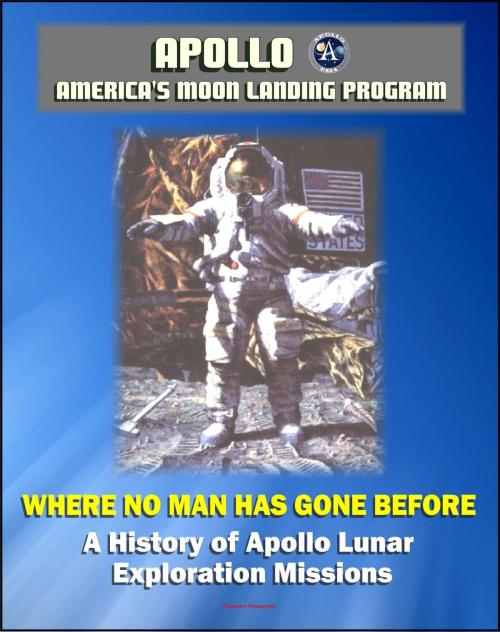Apollo and America's Moon Landing Program: Where No Man Has Gone Before, A History of Apollo Lunar Exploration Missions - Science and Engineering History, Crews, Mission Planning (NASA SP-4214)
Nonfiction, Science & Nature, Science, Physics, Astronomy, History, Americas| Author: | Progressive Management | ISBN: | 9781466171077 |
| Publisher: | Progressive Management | Publication: | November 12, 2011 |
| Imprint: | Smashwords Edition | Language: | English |
| Author: | Progressive Management |
| ISBN: | 9781466171077 |
| Publisher: | Progressive Management |
| Publication: | November 12, 2011 |
| Imprint: | Smashwords Edition |
| Language: | English |
This official NASA history document - converted for accurate flowing-text e-book format reproduction - is an extraordinary review of the planning and problem solving involved in the lunar surface operations of the Apollo program. It chronicles the tug-of-war between scientists and program officials over experiments, missions, landing sites, and crew selection.
The preface states: "The purpose of this book is only partly to record the engineering and scientific accomplishments of the men and women who made it possible for a human to step away from his home planet for the first time. It is primarily an attempt to show how scientists interested in the moon and engineers interested in landing people on the moon worked out their differences and conducted a program that was a major contribution to science as well as a stunning engineering accomplishment. When scientific requirements began to be imposed on manned space flight operations, hardly any aspect was unaffected. The choice of landing sites, the amount of scientific equipment that could be carried, and the weight of lunar material that could be brought back all depended on the capabilities of the spacecraft and mission operations. These considerations limited the earliest missions and constituted the challenge of the later ones. President John F. Kennedy's decision to build the United States' space program around a manned lunar landing owed nothing to any scientific interest in the moon. The primary dividend was to be national prestige, which had suffered from the Soviet Union's early accomplishments in space. A second, equally important result of a manned lunar landing would be the creation of a national capability to operate in space for purposes that might not be foreseeable. Finally, Kennedy felt the need for the country to set aside "business as usual" and commit itself with dedication and discipline to a goal that was both difficult and worthwhile. Kennedy had the assurance of those in the best position to know that it was technologically possible to put a human on the moon within the decade. His political advisers, while stressing the many benefits (including science) that would accrue from a strong space program, recognized at once that humans were the key. If the Soviets sent men and women to the moon, no American robot, however sophisticated or important, would produce an equal impact on the world's consciousness. Hence America's leadership in space would be asserted by landing humans on the moon."
Contents of the fourteen chapters include: America Starts for the Moon: 1957-1963 * Linking Science to Manned Space Flight * Apollo's Lunar Exploration Plans * Handling Samples from the Moon * Selecting and Training the Crews * Mission and Science Planning * Setback and Recovery: 1967 * Final Preparations: 1968 * Primary Mission Accomplished * Lunar Exploration Begins * First Phase of Lunar Exploration Completed: 1969-1970 * Apollo Assumes Its Final Form: 1970-1971 * Lunar Exploration Concluded * Project Apollo: The Conclusion. Other material includes: Chronology Of Major Events In Manned Space Flight And In Project Apollo, 1957-1975 * Crew Training and Simulations * The Flight of Apollo 13.
This official NASA history document - converted for accurate flowing-text e-book format reproduction - is an extraordinary review of the planning and problem solving involved in the lunar surface operations of the Apollo program. It chronicles the tug-of-war between scientists and program officials over experiments, missions, landing sites, and crew selection.
The preface states: "The purpose of this book is only partly to record the engineering and scientific accomplishments of the men and women who made it possible for a human to step away from his home planet for the first time. It is primarily an attempt to show how scientists interested in the moon and engineers interested in landing people on the moon worked out their differences and conducted a program that was a major contribution to science as well as a stunning engineering accomplishment. When scientific requirements began to be imposed on manned space flight operations, hardly any aspect was unaffected. The choice of landing sites, the amount of scientific equipment that could be carried, and the weight of lunar material that could be brought back all depended on the capabilities of the spacecraft and mission operations. These considerations limited the earliest missions and constituted the challenge of the later ones. President John F. Kennedy's decision to build the United States' space program around a manned lunar landing owed nothing to any scientific interest in the moon. The primary dividend was to be national prestige, which had suffered from the Soviet Union's early accomplishments in space. A second, equally important result of a manned lunar landing would be the creation of a national capability to operate in space for purposes that might not be foreseeable. Finally, Kennedy felt the need for the country to set aside "business as usual" and commit itself with dedication and discipline to a goal that was both difficult and worthwhile. Kennedy had the assurance of those in the best position to know that it was technologically possible to put a human on the moon within the decade. His political advisers, while stressing the many benefits (including science) that would accrue from a strong space program, recognized at once that humans were the key. If the Soviets sent men and women to the moon, no American robot, however sophisticated or important, would produce an equal impact on the world's consciousness. Hence America's leadership in space would be asserted by landing humans on the moon."
Contents of the fourteen chapters include: America Starts for the Moon: 1957-1963 * Linking Science to Manned Space Flight * Apollo's Lunar Exploration Plans * Handling Samples from the Moon * Selecting and Training the Crews * Mission and Science Planning * Setback and Recovery: 1967 * Final Preparations: 1968 * Primary Mission Accomplished * Lunar Exploration Begins * First Phase of Lunar Exploration Completed: 1969-1970 * Apollo Assumes Its Final Form: 1970-1971 * Lunar Exploration Concluded * Project Apollo: The Conclusion. Other material includes: Chronology Of Major Events In Manned Space Flight And In Project Apollo, 1957-1975 * Crew Training and Simulations * The Flight of Apollo 13.















